Depression: A Literature Review
VerifiedAdded on 2023/06/10
|14
|4019
|162
AI Summary
This literature review discusses the association between stress and depression, depression physiology, and future directions for research. It provides information about the mental problems of their mental problems, which come to the patient in their daily life.
Contribute Materials
Your contribution can guide someone’s learning journey. Share your
documents today.
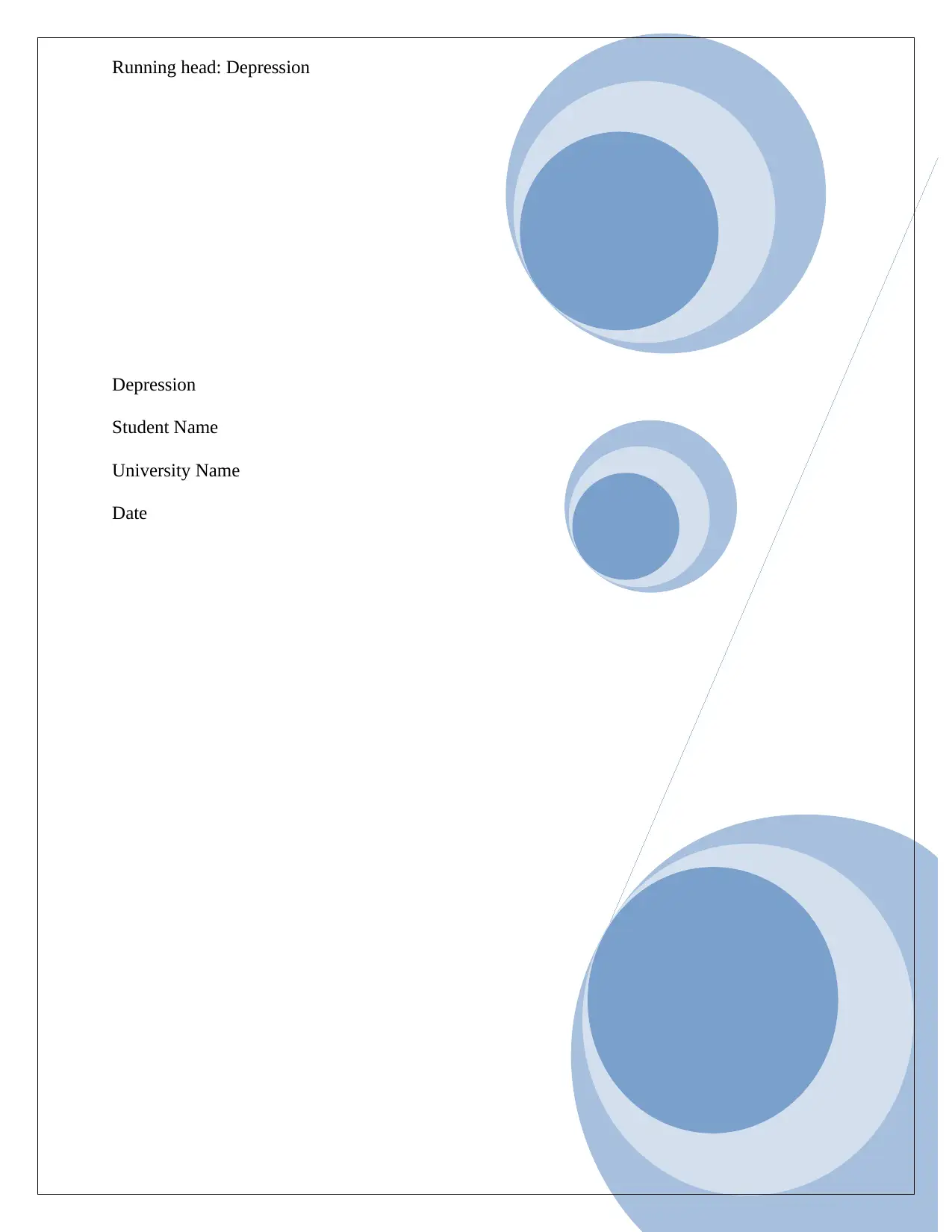
Running head: Depression
Depression
Student Name
University Name
Date
Depression
Student Name
University Name
Date
Secure Best Marks with AI Grader
Need help grading? Try our AI Grader for instant feedback on your assignments.
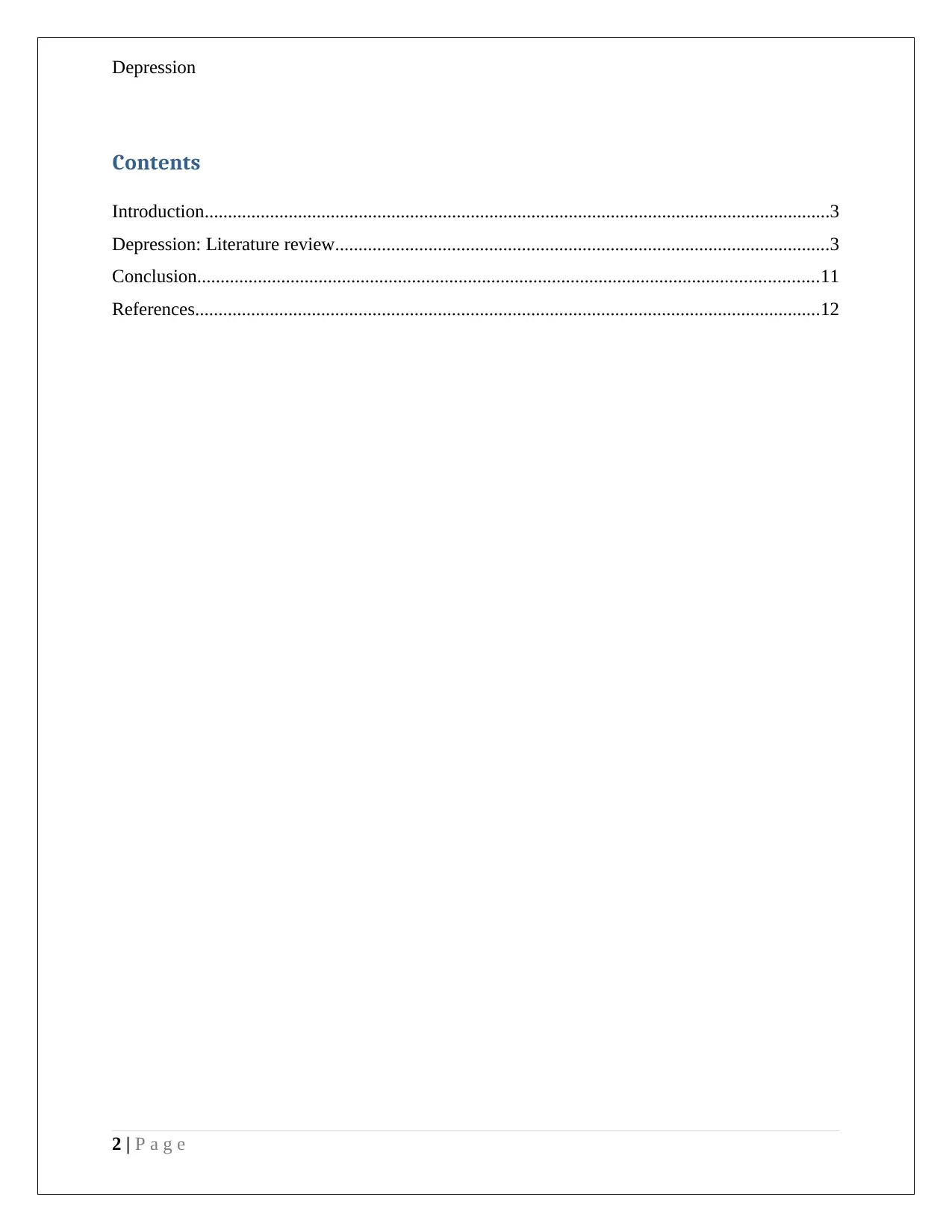
Depression
Contents
Introduction......................................................................................................................................3
Depression: Literature review..........................................................................................................3
Conclusion.....................................................................................................................................11
References......................................................................................................................................12
2 | P a g e
Contents
Introduction......................................................................................................................................3
Depression: Literature review..........................................................................................................3
Conclusion.....................................................................................................................................11
References......................................................................................................................................12
2 | P a g e
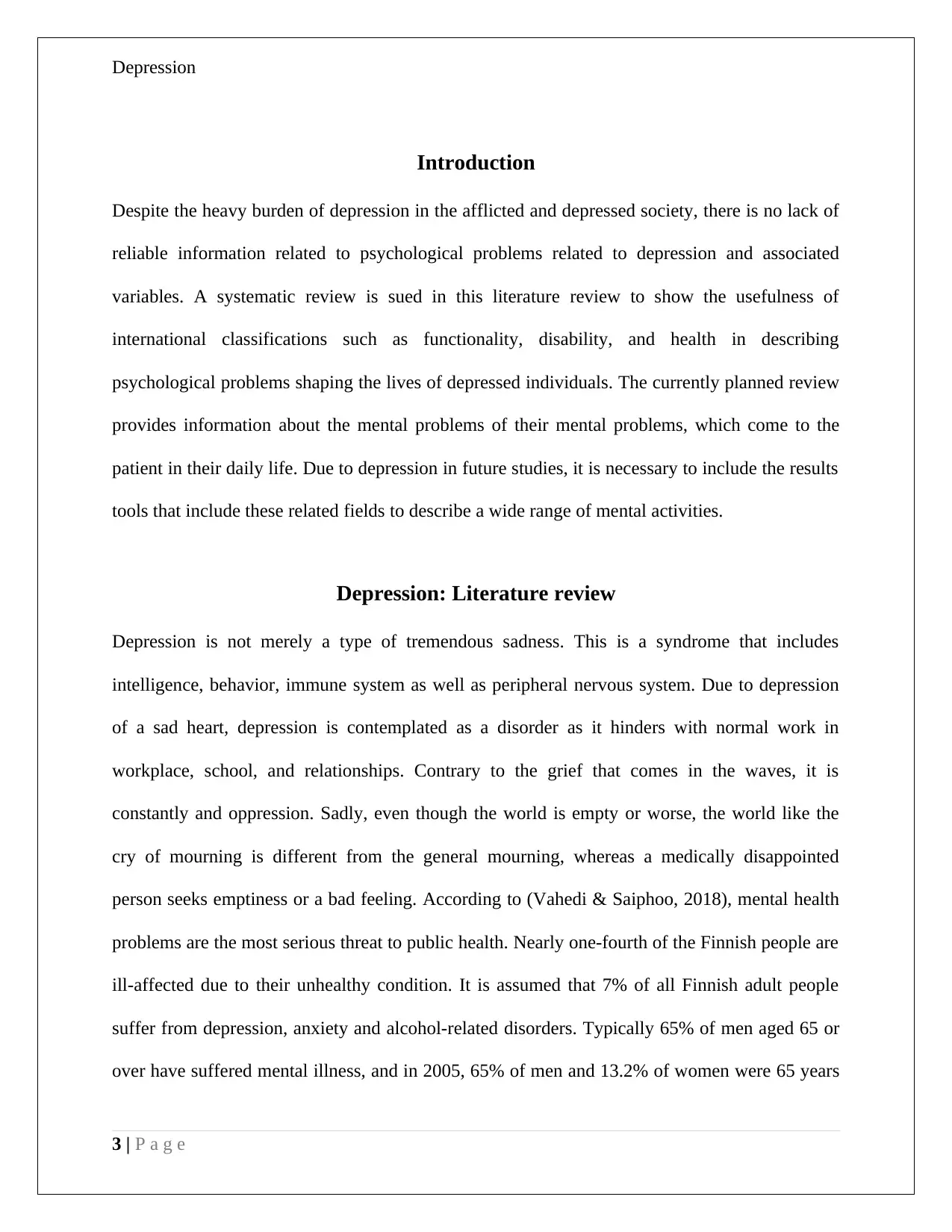
Depression
Introduction
Despite the heavy burden of depression in the afflicted and depressed society, there is no lack of
reliable information related to psychological problems related to depression and associated
variables. A systematic review is sued in this literature review to show the usefulness of
international classifications such as functionality, disability, and health in describing
psychological problems shaping the lives of depressed individuals. The currently planned review
provides information about the mental problems of their mental problems, which come to the
patient in their daily life. Due to depression in future studies, it is necessary to include the results
tools that include these related fields to describe a wide range of mental activities.
Depression: Literature review
Depression is not merely a type of tremendous sadness. This is a syndrome that includes
intelligence, behavior, immune system as well as peripheral nervous system. Due to depression
of a sad heart, depression is contemplated as a disorder as it hinders with normal work in
workplace, school, and relationships. Contrary to the grief that comes in the waves, it is
constantly and oppression. Sadly, even though the world is empty or worse, the world like the
cry of mourning is different from the general mourning, whereas a medically disappointed
person seeks emptiness or a bad feeling. According to (Vahedi & Saiphoo, 2018), mental health
problems are the most serious threat to public health. Nearly one-fourth of the Finnish people are
ill-affected due to their unhealthy condition. It is assumed that 7% of all Finnish adult people
suffer from depression, anxiety and alcohol-related disorders. Typically 65% of men aged 65 or
over have suffered mental illness, and in 2005, 65% of men and 13.2% of women were 65 years
3 | P a g e
Introduction
Despite the heavy burden of depression in the afflicted and depressed society, there is no lack of
reliable information related to psychological problems related to depression and associated
variables. A systematic review is sued in this literature review to show the usefulness of
international classifications such as functionality, disability, and health in describing
psychological problems shaping the lives of depressed individuals. The currently planned review
provides information about the mental problems of their mental problems, which come to the
patient in their daily life. Due to depression in future studies, it is necessary to include the results
tools that include these related fields to describe a wide range of mental activities.
Depression: Literature review
Depression is not merely a type of tremendous sadness. This is a syndrome that includes
intelligence, behavior, immune system as well as peripheral nervous system. Due to depression
of a sad heart, depression is contemplated as a disorder as it hinders with normal work in
workplace, school, and relationships. Contrary to the grief that comes in the waves, it is
constantly and oppression. Sadly, even though the world is empty or worse, the world like the
cry of mourning is different from the general mourning, whereas a medically disappointed
person seeks emptiness or a bad feeling. According to (Vahedi & Saiphoo, 2018), mental health
problems are the most serious threat to public health. Nearly one-fourth of the Finnish people are
ill-affected due to their unhealthy condition. It is assumed that 7% of all Finnish adult people
suffer from depression, anxiety and alcohol-related disorders. Typically 65% of men aged 65 or
over have suffered mental illness, and in 2005, 65% of men and 13.2% of women were 65 years
3 | P a g e
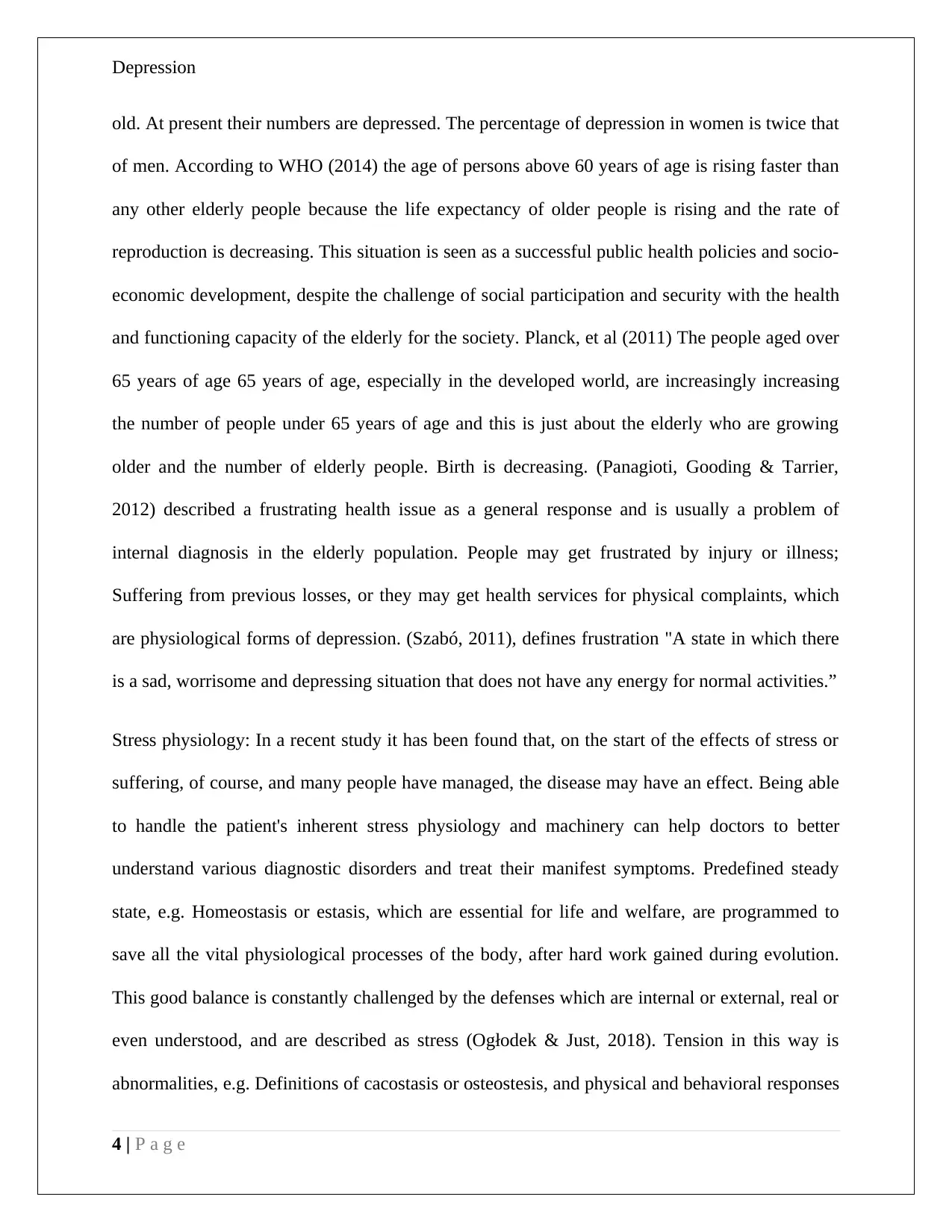
Depression
old. At present their numbers are depressed. The percentage of depression in women is twice that
of men. According to WHO (2014) the age of persons above 60 years of age is rising faster than
any other elderly people because the life expectancy of older people is rising and the rate of
reproduction is decreasing. This situation is seen as a successful public health policies and socio-
economic development, despite the challenge of social participation and security with the health
and functioning capacity of the elderly for the society. Planck, et al (2011) The people aged over
65 years of age 65 years of age, especially in the developed world, are increasingly increasing
the number of people under 65 years of age and this is just about the elderly who are growing
older and the number of elderly people. Birth is decreasing. (Panagioti, Gooding & Tarrier,
2012) described a frustrating health issue as a general response and is usually a problem of
internal diagnosis in the elderly population. People may get frustrated by injury or illness;
Suffering from previous losses, or they may get health services for physical complaints, which
are physiological forms of depression. (Szabó, 2011), defines frustration "A state in which there
is a sad, worrisome and depressing situation that does not have any energy for normal activities.”
Stress physiology: In a recent study it has been found that, on the start of the effects of stress or
suffering, of course, and many people have managed, the disease may have an effect. Being able
to handle the patient's inherent stress physiology and machinery can help doctors to better
understand various diagnostic disorders and treat their manifest symptoms. Predefined steady
state, e.g. Homeostasis or estasis, which are essential for life and welfare, are programmed to
save all the vital physiological processes of the body, after hard work gained during evolution.
This good balance is constantly challenged by the defenses which are internal or external, real or
even understood, and are described as stress (Ogłodek & Just, 2018). Tension in this way is
abnormalities, e.g. Definitions of cacostasis or osteostesis, and physical and behavioral responses
4 | P a g e
old. At present their numbers are depressed. The percentage of depression in women is twice that
of men. According to WHO (2014) the age of persons above 60 years of age is rising faster than
any other elderly people because the life expectancy of older people is rising and the rate of
reproduction is decreasing. This situation is seen as a successful public health policies and socio-
economic development, despite the challenge of social participation and security with the health
and functioning capacity of the elderly for the society. Planck, et al (2011) The people aged over
65 years of age 65 years of age, especially in the developed world, are increasingly increasing
the number of people under 65 years of age and this is just about the elderly who are growing
older and the number of elderly people. Birth is decreasing. (Panagioti, Gooding & Tarrier,
2012) described a frustrating health issue as a general response and is usually a problem of
internal diagnosis in the elderly population. People may get frustrated by injury or illness;
Suffering from previous losses, or they may get health services for physical complaints, which
are physiological forms of depression. (Szabó, 2011), defines frustration "A state in which there
is a sad, worrisome and depressing situation that does not have any energy for normal activities.”
Stress physiology: In a recent study it has been found that, on the start of the effects of stress or
suffering, of course, and many people have managed, the disease may have an effect. Being able
to handle the patient's inherent stress physiology and machinery can help doctors to better
understand various diagnostic disorders and treat their manifest symptoms. Predefined steady
state, e.g. Homeostasis or estasis, which are essential for life and welfare, are programmed to
save all the vital physiological processes of the body, after hard work gained during evolution.
This good balance is constantly challenged by the defenses which are internal or external, real or
even understood, and are described as stress (Ogłodek & Just, 2018). Tension in this way is
abnormalities, e.g. Definitions of cacostasis or osteostesis, and physical and behavioral responses
4 | P a g e
Secure Best Marks with AI Grader
Need help grading? Try our AI Grader for instant feedback on your assignments.
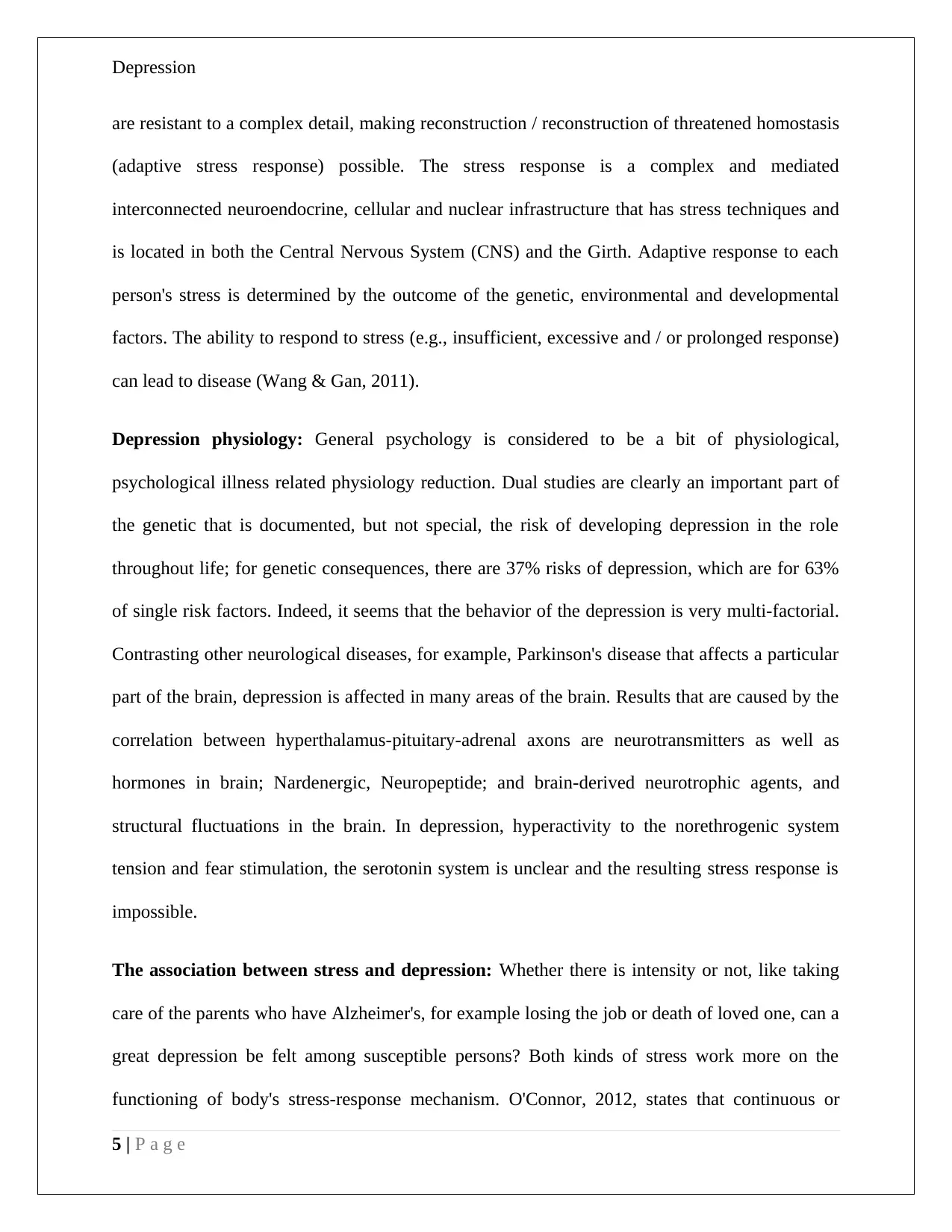
Depression
are resistant to a complex detail, making reconstruction / reconstruction of threatened homostasis
(adaptive stress response) possible. The stress response is a complex and mediated
interconnected neuroendocrine, cellular and nuclear infrastructure that has stress techniques and
is located in both the Central Nervous System (CNS) and the Girth. Adaptive response to each
person's stress is determined by the outcome of the genetic, environmental and developmental
factors. The ability to respond to stress (e.g., insufficient, excessive and / or prolonged response)
can lead to disease (Wang & Gan, 2011).
Depression physiology: General psychology is considered to be a bit of physiological,
psychological illness related physiology reduction. Dual studies are clearly an important part of
the genetic that is documented, but not special, the risk of developing depression in the role
throughout life; for genetic consequences, there are 37% risks of depression, which are for 63%
of single risk factors. Indeed, it seems that the behavior of the depression is very multi-factorial.
Contrasting other neurological diseases, for example, Parkinson's disease that affects a particular
part of the brain, depression is affected in many areas of the brain. Results that are caused by the
correlation between hyperthalamus-pituitary-adrenal axons are neurotransmitters as well as
hormones in brain; Nardenergic, Neuropeptide; and brain-derived neurotrophic agents, and
structural fluctuations in the brain. In depression, hyperactivity to the norethrogenic system
tension and fear stimulation, the serotonin system is unclear and the resulting stress response is
impossible.
The association between stress and depression: Whether there is intensity or not, like taking
care of the parents who have Alzheimer's, for example losing the job or death of loved one, can a
great depression be felt among susceptible persons? Both kinds of stress work more on the
functioning of body's stress-response mechanism. O'Connor, 2012, states that continuous or
5 | P a g e
are resistant to a complex detail, making reconstruction / reconstruction of threatened homostasis
(adaptive stress response) possible. The stress response is a complex and mediated
interconnected neuroendocrine, cellular and nuclear infrastructure that has stress techniques and
is located in both the Central Nervous System (CNS) and the Girth. Adaptive response to each
person's stress is determined by the outcome of the genetic, environmental and developmental
factors. The ability to respond to stress (e.g., insufficient, excessive and / or prolonged response)
can lead to disease (Wang & Gan, 2011).
Depression physiology: General psychology is considered to be a bit of physiological,
psychological illness related physiology reduction. Dual studies are clearly an important part of
the genetic that is documented, but not special, the risk of developing depression in the role
throughout life; for genetic consequences, there are 37% risks of depression, which are for 63%
of single risk factors. Indeed, it seems that the behavior of the depression is very multi-factorial.
Contrasting other neurological diseases, for example, Parkinson's disease that affects a particular
part of the brain, depression is affected in many areas of the brain. Results that are caused by the
correlation between hyperthalamus-pituitary-adrenal axons are neurotransmitters as well as
hormones in brain; Nardenergic, Neuropeptide; and brain-derived neurotrophic agents, and
structural fluctuations in the brain. In depression, hyperactivity to the norethrogenic system
tension and fear stimulation, the serotonin system is unclear and the resulting stress response is
impossible.
The association between stress and depression: Whether there is intensity or not, like taking
care of the parents who have Alzheimer's, for example losing the job or death of loved one, can a
great depression be felt among susceptible persons? Both kinds of stress work more on the
functioning of body's stress-response mechanism. O'Connor, 2012, states that continuous or
5 | P a g e
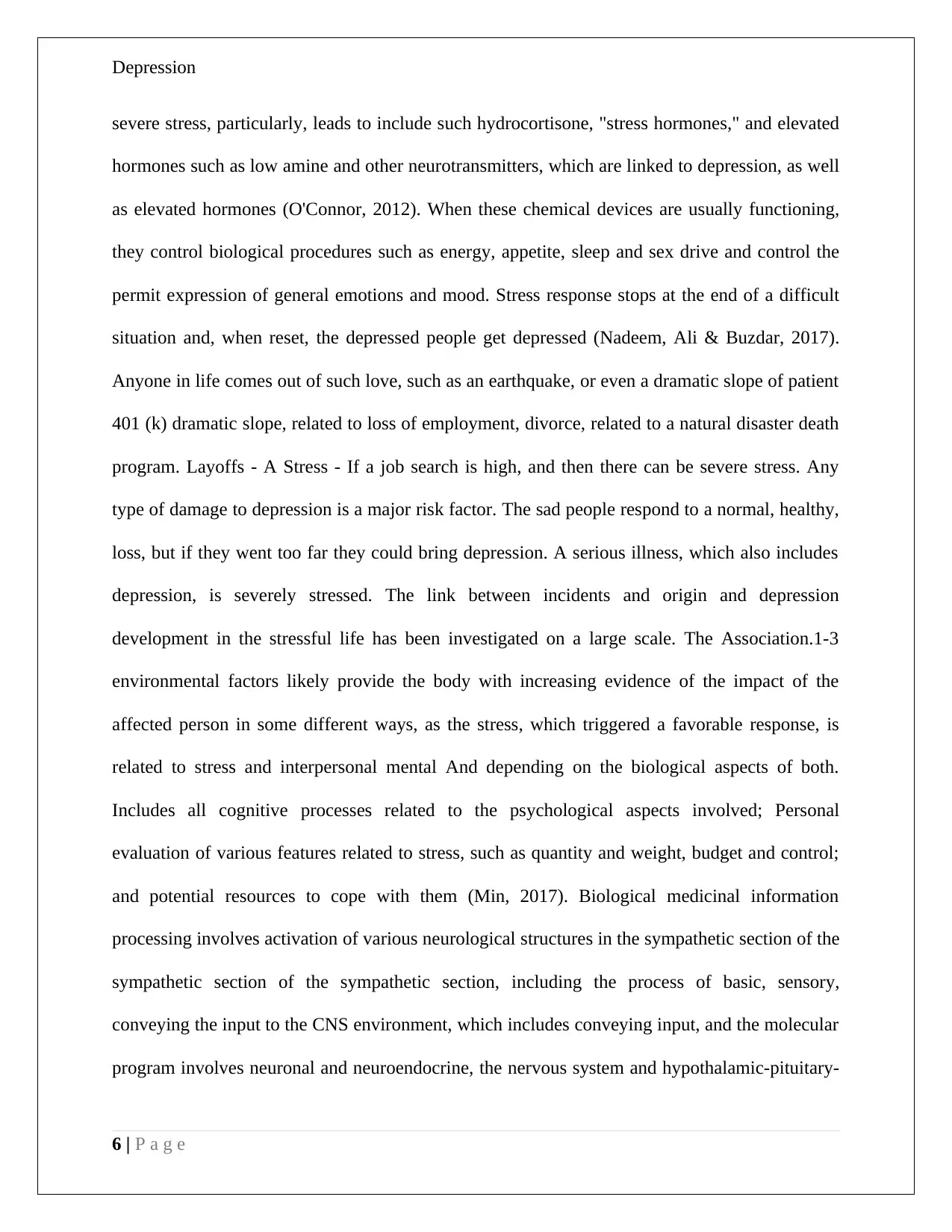
Depression
severe stress, particularly, leads to include such hydrocortisone, "stress hormones," and elevated
hormones such as low amine and other neurotransmitters, which are linked to depression, as well
as elevated hormones (O'Connor, 2012). When these chemical devices are usually functioning,
they control biological procedures such as energy, appetite, sleep and sex drive and control the
permit expression of general emotions and mood. Stress response stops at the end of a difficult
situation and, when reset, the depressed people get depressed (Nadeem, Ali & Buzdar, 2017).
Anyone in life comes out of such love, such as an earthquake, or even a dramatic slope of patient
401 (k) dramatic slope, related to loss of employment, divorce, related to a natural disaster death
program. Layoffs - A Stress - If a job search is high, and then there can be severe stress. Any
type of damage to depression is a major risk factor. The sad people respond to a normal, healthy,
loss, but if they went too far they could bring depression. A serious illness, which also includes
depression, is severely stressed. The link between incidents and origin and depression
development in the stressful life has been investigated on a large scale. The Association.1-3
environmental factors likely provide the body with increasing evidence of the impact of the
affected person in some different ways, as the stress, which triggered a favorable response, is
related to stress and interpersonal mental And depending on the biological aspects of both.
Includes all cognitive processes related to the psychological aspects involved; Personal
evaluation of various features related to stress, such as quantity and weight, budget and control;
and potential resources to cope with them (Min, 2017). Biological medicinal information
processing involves activation of various neurological structures in the sympathetic section of the
sympathetic section of the sympathetic section, including the process of basic, sensory,
conveying the input to the CNS environment, which includes conveying input, and the molecular
program involves neuronal and neuroendocrine, the nervous system and hypothalamic-pituitary-
6 | P a g e
severe stress, particularly, leads to include such hydrocortisone, "stress hormones," and elevated
hormones such as low amine and other neurotransmitters, which are linked to depression, as well
as elevated hormones (O'Connor, 2012). When these chemical devices are usually functioning,
they control biological procedures such as energy, appetite, sleep and sex drive and control the
permit expression of general emotions and mood. Stress response stops at the end of a difficult
situation and, when reset, the depressed people get depressed (Nadeem, Ali & Buzdar, 2017).
Anyone in life comes out of such love, such as an earthquake, or even a dramatic slope of patient
401 (k) dramatic slope, related to loss of employment, divorce, related to a natural disaster death
program. Layoffs - A Stress - If a job search is high, and then there can be severe stress. Any
type of damage to depression is a major risk factor. The sad people respond to a normal, healthy,
loss, but if they went too far they could bring depression. A serious illness, which also includes
depression, is severely stressed. The link between incidents and origin and depression
development in the stressful life has been investigated on a large scale. The Association.1-3
environmental factors likely provide the body with increasing evidence of the impact of the
affected person in some different ways, as the stress, which triggered a favorable response, is
related to stress and interpersonal mental And depending on the biological aspects of both.
Includes all cognitive processes related to the psychological aspects involved; Personal
evaluation of various features related to stress, such as quantity and weight, budget and control;
and potential resources to cope with them (Min, 2017). Biological medicinal information
processing involves activation of various neurological structures in the sympathetic section of the
sympathetic section of the sympathetic section, including the process of basic, sensory,
conveying the input to the CNS environment, which includes conveying input, and the molecular
program involves neuronal and neuroendocrine, the nervous system and hypothalamic-pituitary-
6 | P a g e
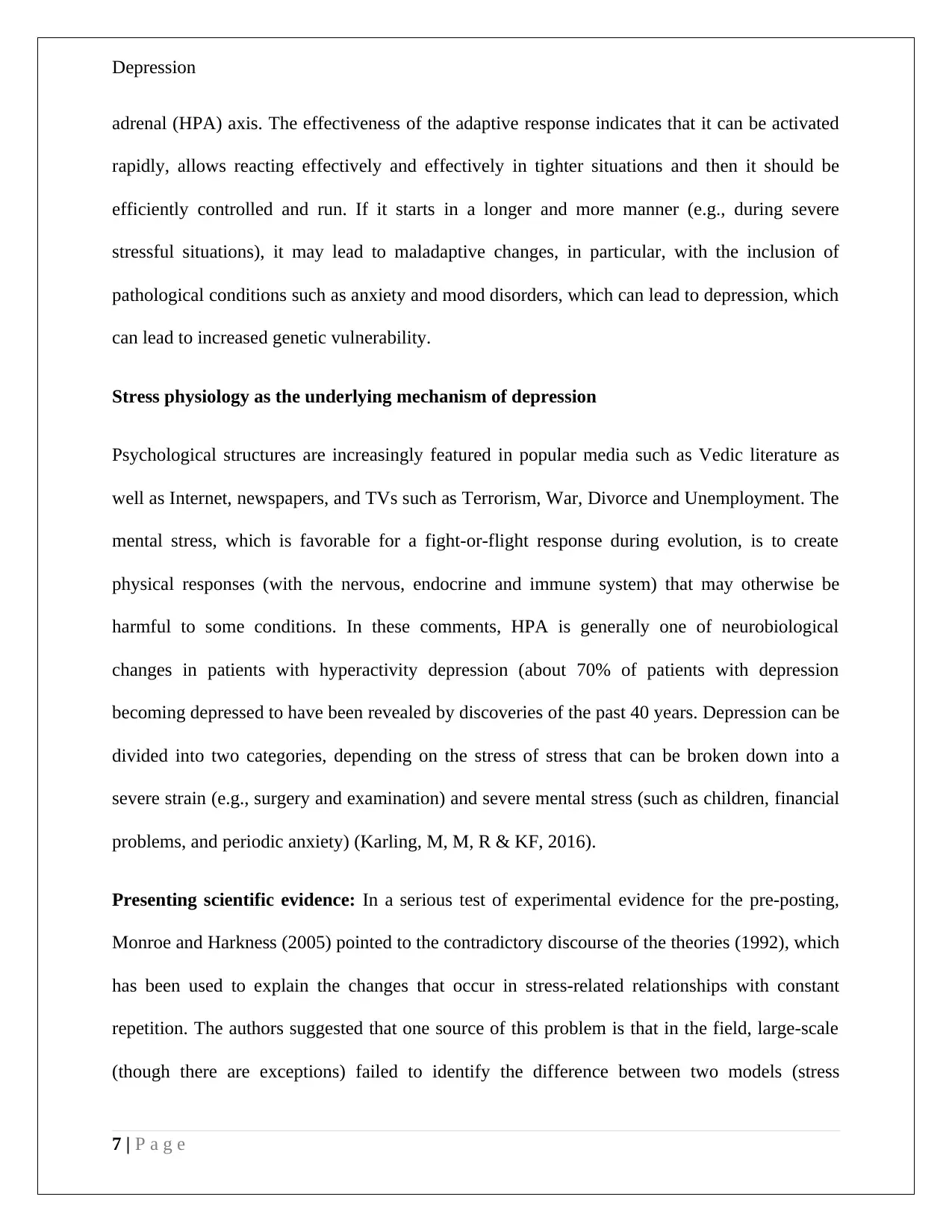
Depression
adrenal (HPA) axis. The effectiveness of the adaptive response indicates that it can be activated
rapidly, allows reacting effectively and effectively in tighter situations and then it should be
efficiently controlled and run. If it starts in a longer and more manner (e.g., during severe
stressful situations), it may lead to maladaptive changes, in particular, with the inclusion of
pathological conditions such as anxiety and mood disorders, which can lead to depression, which
can lead to increased genetic vulnerability.
Stress physiology as the underlying mechanism of depression
Psychological structures are increasingly featured in popular media such as Vedic literature as
well as Internet, newspapers, and TVs such as Terrorism, War, Divorce and Unemployment. The
mental stress, which is favorable for a fight-or-flight response during evolution, is to create
physical responses (with the nervous, endocrine and immune system) that may otherwise be
harmful to some conditions. In these comments, HPA is generally one of neurobiological
changes in patients with hyperactivity depression (about 70% of patients with depression
becoming depressed to have been revealed by discoveries of the past 40 years. Depression can be
divided into two categories, depending on the stress of stress that can be broken down into a
severe strain (e.g., surgery and examination) and severe mental stress (such as children, financial
problems, and periodic anxiety) (Karling, M, M, R & KF, 2016).
Presenting scientific evidence: In a serious test of experimental evidence for the pre-posting,
Monroe and Harkness (2005) pointed to the contradictory discourse of the theories (1992), which
has been used to explain the changes that occur in stress-related relationships with constant
repetition. The authors suggested that one source of this problem is that in the field, large-scale
(though there are exceptions) failed to identify the difference between two models (stress
7 | P a g e
adrenal (HPA) axis. The effectiveness of the adaptive response indicates that it can be activated
rapidly, allows reacting effectively and effectively in tighter situations and then it should be
efficiently controlled and run. If it starts in a longer and more manner (e.g., during severe
stressful situations), it may lead to maladaptive changes, in particular, with the inclusion of
pathological conditions such as anxiety and mood disorders, which can lead to depression, which
can lead to increased genetic vulnerability.
Stress physiology as the underlying mechanism of depression
Psychological structures are increasingly featured in popular media such as Vedic literature as
well as Internet, newspapers, and TVs such as Terrorism, War, Divorce and Unemployment. The
mental stress, which is favorable for a fight-or-flight response during evolution, is to create
physical responses (with the nervous, endocrine and immune system) that may otherwise be
harmful to some conditions. In these comments, HPA is generally one of neurobiological
changes in patients with hyperactivity depression (about 70% of patients with depression
becoming depressed to have been revealed by discoveries of the past 40 years. Depression can be
divided into two categories, depending on the stress of stress that can be broken down into a
severe strain (e.g., surgery and examination) and severe mental stress (such as children, financial
problems, and periodic anxiety) (Karling, M, M, R & KF, 2016).
Presenting scientific evidence: In a serious test of experimental evidence for the pre-posting,
Monroe and Harkness (2005) pointed to the contradictory discourse of the theories (1992), which
has been used to explain the changes that occur in stress-related relationships with constant
repetition. The authors suggested that one source of this problem is that in the field, large-scale
(though there are exceptions) failed to identify the difference between two models (stress
7 | P a g e
Paraphrase This Document
Need a fresh take? Get an instant paraphrase of this document with our AI Paraphraser
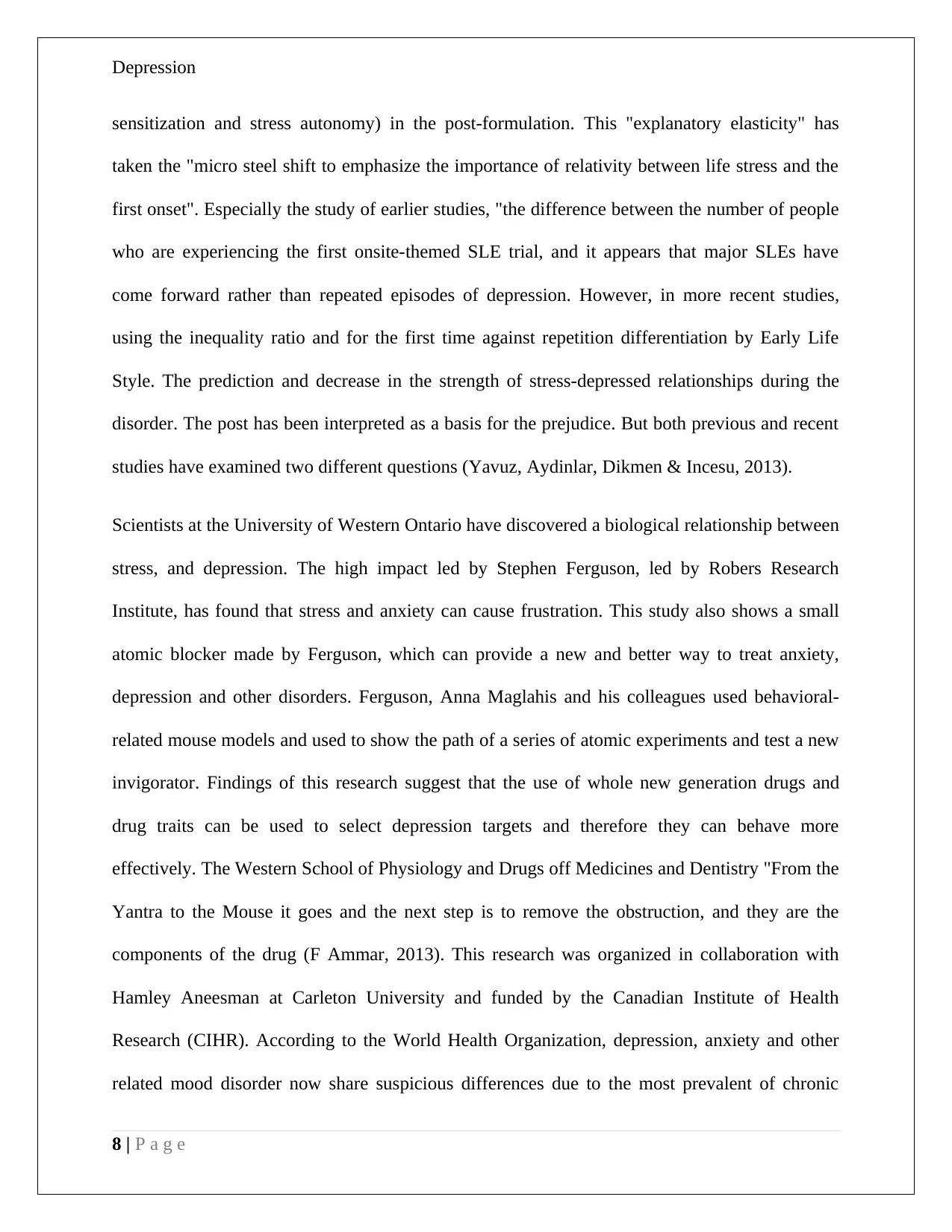
Depression
sensitization and stress autonomy) in the post-formulation. This "explanatory elasticity" has
taken the "micro steel shift to emphasize the importance of relativity between life stress and the
first onset". Especially the study of earlier studies, "the difference between the number of people
who are experiencing the first onsite-themed SLE trial, and it appears that major SLEs have
come forward rather than repeated episodes of depression. However, in more recent studies,
using the inequality ratio and for the first time against repetition differentiation by Early Life
Style. The prediction and decrease in the strength of stress-depressed relationships during the
disorder. The post has been interpreted as a basis for the prejudice. But both previous and recent
studies have examined two different questions (Yavuz, Aydinlar, Dikmen & Incesu, 2013).
Scientists at the University of Western Ontario have discovered a biological relationship between
stress, and depression. The high impact led by Stephen Ferguson, led by Robers Research
Institute, has found that stress and anxiety can cause frustration. This study also shows a small
atomic blocker made by Ferguson, which can provide a new and better way to treat anxiety,
depression and other disorders. Ferguson, Anna Maglahis and his colleagues used behavioral-
related mouse models and used to show the path of a series of atomic experiments and test a new
invigorator. Findings of this research suggest that the use of whole new generation drugs and
drug traits can be used to select depression targets and therefore they can behave more
effectively. The Western School of Physiology and Drugs off Medicines and Dentistry "From the
Yantra to the Mouse it goes and the next step is to remove the obstruction, and they are the
components of the drug (F Ammar, 2013). This research was organized in collaboration with
Hamley Aneesman at Carleton University and funded by the Canadian Institute of Health
Research (CIHR). According to the World Health Organization, depression, anxiety and other
related mood disorder now share suspicious differences due to the most prevalent of chronic
8 | P a g e
sensitization and stress autonomy) in the post-formulation. This "explanatory elasticity" has
taken the "micro steel shift to emphasize the importance of relativity between life stress and the
first onset". Especially the study of earlier studies, "the difference between the number of people
who are experiencing the first onsite-themed SLE trial, and it appears that major SLEs have
come forward rather than repeated episodes of depression. However, in more recent studies,
using the inequality ratio and for the first time against repetition differentiation by Early Life
Style. The prediction and decrease in the strength of stress-depressed relationships during the
disorder. The post has been interpreted as a basis for the prejudice. But both previous and recent
studies have examined two different questions (Yavuz, Aydinlar, Dikmen & Incesu, 2013).
Scientists at the University of Western Ontario have discovered a biological relationship between
stress, and depression. The high impact led by Stephen Ferguson, led by Robers Research
Institute, has found that stress and anxiety can cause frustration. This study also shows a small
atomic blocker made by Ferguson, which can provide a new and better way to treat anxiety,
depression and other disorders. Ferguson, Anna Maglahis and his colleagues used behavioral-
related mouse models and used to show the path of a series of atomic experiments and test a new
invigorator. Findings of this research suggest that the use of whole new generation drugs and
drug traits can be used to select depression targets and therefore they can behave more
effectively. The Western School of Physiology and Drugs off Medicines and Dentistry "From the
Yantra to the Mouse it goes and the next step is to remove the obstruction, and they are the
components of the drug (F Ammar, 2013). This research was organized in collaboration with
Hamley Aneesman at Carleton University and funded by the Canadian Institute of Health
Research (CIHR). According to the World Health Organization, depression, anxiety and other
related mood disorder now share suspicious differences due to the most prevalent of chronic
8 | P a g e
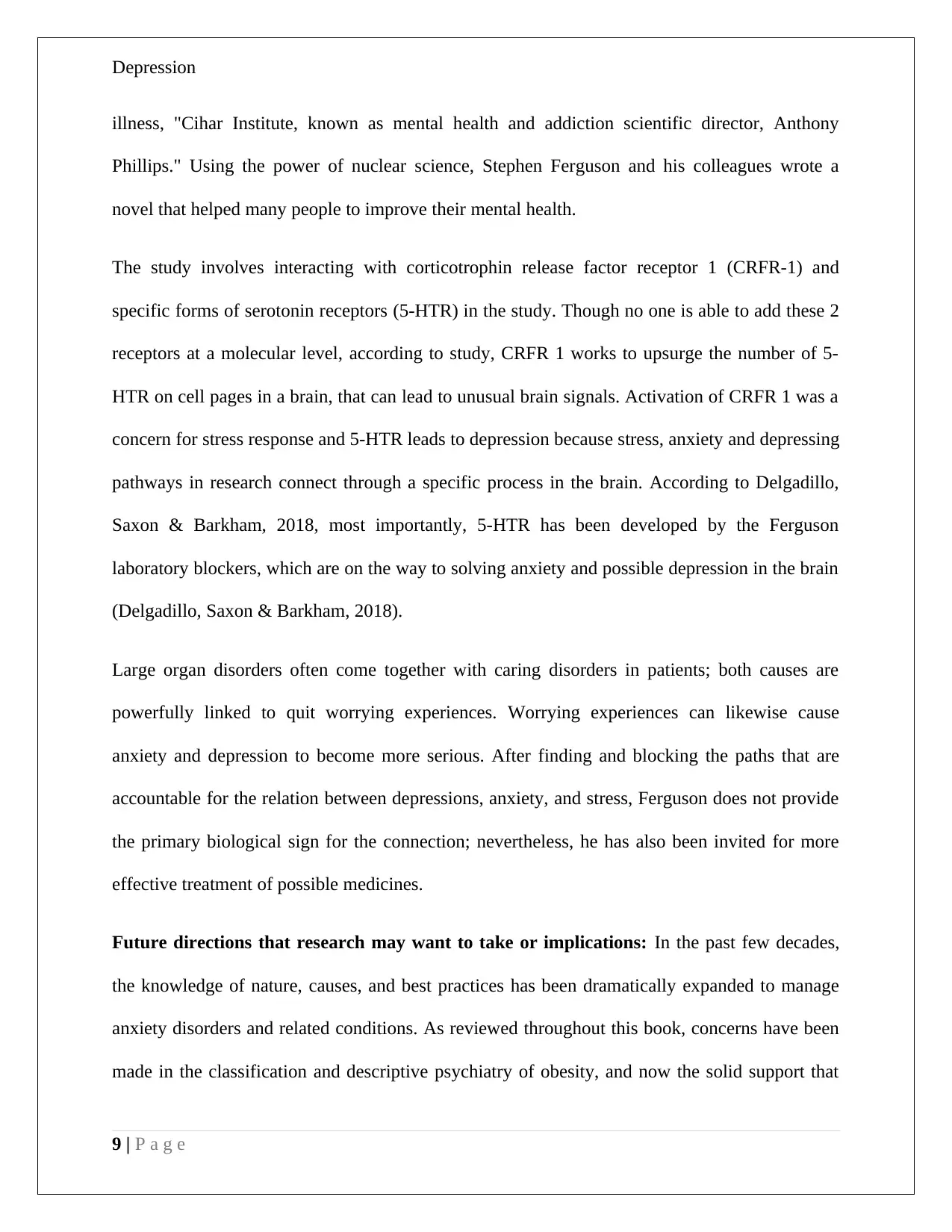
Depression
illness, "Cihar Institute, known as mental health and addiction scientific director, Anthony
Phillips." Using the power of nuclear science, Stephen Ferguson and his colleagues wrote a
novel that helped many people to improve their mental health.
The study involves interacting with corticotrophin release factor receptor 1 (CRFR-1) and
specific forms of serotonin receptors (5-HTR) in the study. Though no one is able to add these 2
receptors at a molecular level, according to study, CRFR 1 works to upsurge the number of 5-
HTR on cell pages in a brain, that can lead to unusual brain signals. Activation of CRFR 1 was a
concern for stress response and 5-HTR leads to depression because stress, anxiety and depressing
pathways in research connect through a specific process in the brain. According to Delgadillo,
Saxon & Barkham, 2018, most importantly, 5-HTR has been developed by the Ferguson
laboratory blockers, which are on the way to solving anxiety and possible depression in the brain
(Delgadillo, Saxon & Barkham, 2018).
Large organ disorders often come together with caring disorders in patients; both causes are
powerfully linked to quit worrying experiences. Worrying experiences can likewise cause
anxiety and depression to become more serious. After finding and blocking the paths that are
accountable for the relation between depressions, anxiety, and stress, Ferguson does not provide
the primary biological sign for the connection; nevertheless, he has also been invited for more
effective treatment of possible medicines.
Future directions that research may want to take or implications: In the past few decades,
the knowledge of nature, causes, and best practices has been dramatically expanded to manage
anxiety disorders and related conditions. As reviewed throughout this book, concerns have been
made in the classification and descriptive psychiatry of obesity, and now the solid support that
9 | P a g e
illness, "Cihar Institute, known as mental health and addiction scientific director, Anthony
Phillips." Using the power of nuclear science, Stephen Ferguson and his colleagues wrote a
novel that helped many people to improve their mental health.
The study involves interacting with corticotrophin release factor receptor 1 (CRFR-1) and
specific forms of serotonin receptors (5-HTR) in the study. Though no one is able to add these 2
receptors at a molecular level, according to study, CRFR 1 works to upsurge the number of 5-
HTR on cell pages in a brain, that can lead to unusual brain signals. Activation of CRFR 1 was a
concern for stress response and 5-HTR leads to depression because stress, anxiety and depressing
pathways in research connect through a specific process in the brain. According to Delgadillo,
Saxon & Barkham, 2018, most importantly, 5-HTR has been developed by the Ferguson
laboratory blockers, which are on the way to solving anxiety and possible depression in the brain
(Delgadillo, Saxon & Barkham, 2018).
Large organ disorders often come together with caring disorders in patients; both causes are
powerfully linked to quit worrying experiences. Worrying experiences can likewise cause
anxiety and depression to become more serious. After finding and blocking the paths that are
accountable for the relation between depressions, anxiety, and stress, Ferguson does not provide
the primary biological sign for the connection; nevertheless, he has also been invited for more
effective treatment of possible medicines.
Future directions that research may want to take or implications: In the past few decades,
the knowledge of nature, causes, and best practices has been dramatically expanded to manage
anxiety disorders and related conditions. As reviewed throughout this book, concerns have been
made in the classification and descriptive psychiatry of obesity, and now the solid support that
9 | P a g e
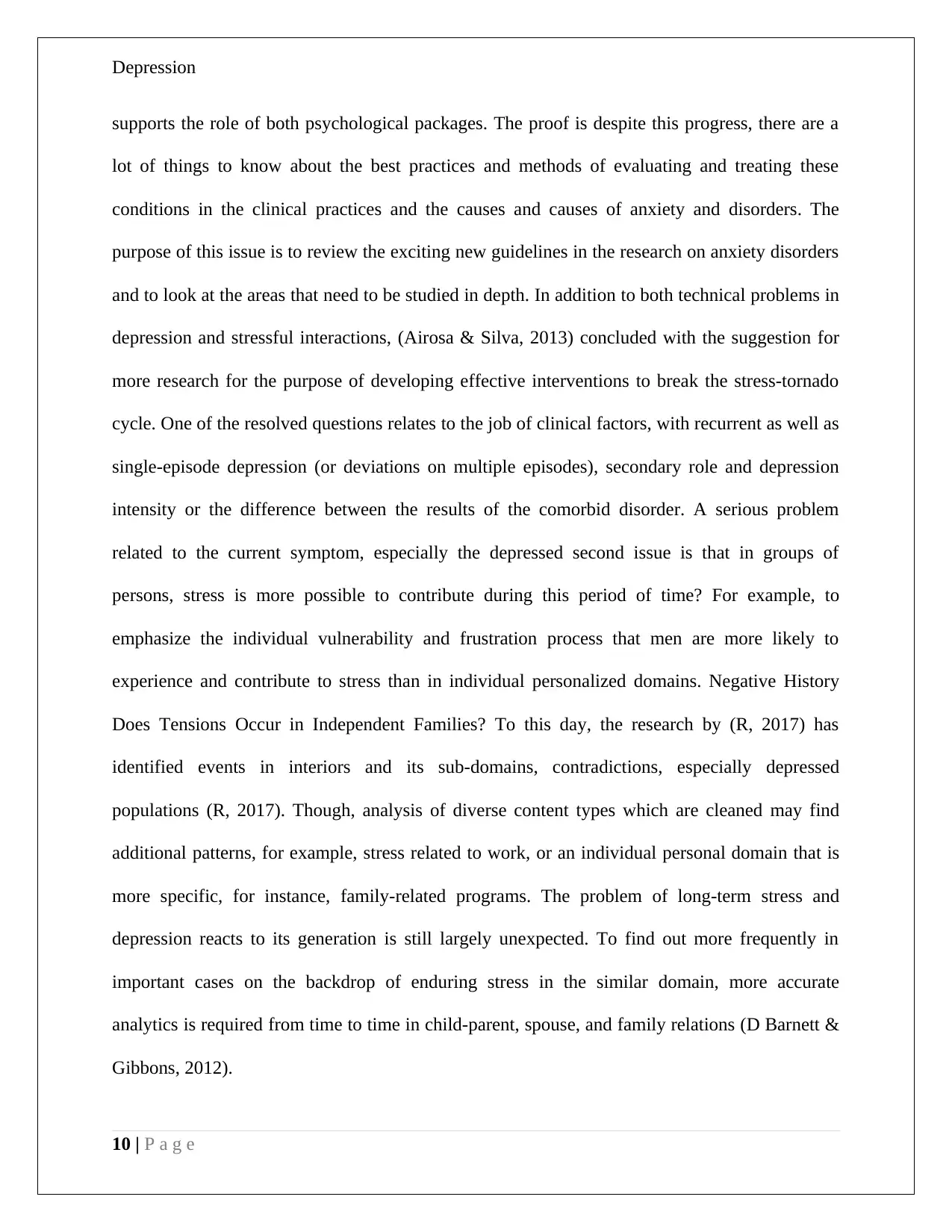
Depression
supports the role of both psychological packages. The proof is despite this progress, there are a
lot of things to know about the best practices and methods of evaluating and treating these
conditions in the clinical practices and the causes and causes of anxiety and disorders. The
purpose of this issue is to review the exciting new guidelines in the research on anxiety disorders
and to look at the areas that need to be studied in depth. In addition to both technical problems in
depression and stressful interactions, (Airosa & Silva, 2013) concluded with the suggestion for
more research for the purpose of developing effective interventions to break the stress-tornado
cycle. One of the resolved questions relates to the job of clinical factors, with recurrent as well as
single-episode depression (or deviations on multiple episodes), secondary role and depression
intensity or the difference between the results of the comorbid disorder. A serious problem
related to the current symptom, especially the depressed second issue is that in groups of
persons, stress is more possible to contribute during this period of time? For example, to
emphasize the individual vulnerability and frustration process that men are more likely to
experience and contribute to stress than in individual personalized domains. Negative History
Does Tensions Occur in Independent Families? To this day, the research by (R, 2017) has
identified events in interiors and its sub-domains, contradictions, especially depressed
populations (R, 2017). Though, analysis of diverse content types which are cleaned may find
additional patterns, for example, stress related to work, or an individual personal domain that is
more specific, for instance, family-related programs. The problem of long-term stress and
depression reacts to its generation is still largely unexpected. To find out more frequently in
important cases on the backdrop of enduring stress in the similar domain, more accurate
analytics is required from time to time in child-parent, spouse, and family relations (D Barnett &
Gibbons, 2012).
10 | P a g e
supports the role of both psychological packages. The proof is despite this progress, there are a
lot of things to know about the best practices and methods of evaluating and treating these
conditions in the clinical practices and the causes and causes of anxiety and disorders. The
purpose of this issue is to review the exciting new guidelines in the research on anxiety disorders
and to look at the areas that need to be studied in depth. In addition to both technical problems in
depression and stressful interactions, (Airosa & Silva, 2013) concluded with the suggestion for
more research for the purpose of developing effective interventions to break the stress-tornado
cycle. One of the resolved questions relates to the job of clinical factors, with recurrent as well as
single-episode depression (or deviations on multiple episodes), secondary role and depression
intensity or the difference between the results of the comorbid disorder. A serious problem
related to the current symptom, especially the depressed second issue is that in groups of
persons, stress is more possible to contribute during this period of time? For example, to
emphasize the individual vulnerability and frustration process that men are more likely to
experience and contribute to stress than in individual personalized domains. Negative History
Does Tensions Occur in Independent Families? To this day, the research by (R, 2017) has
identified events in interiors and its sub-domains, contradictions, especially depressed
populations (R, 2017). Though, analysis of diverse content types which are cleaned may find
additional patterns, for example, stress related to work, or an individual personal domain that is
more specific, for instance, family-related programs. The problem of long-term stress and
depression reacts to its generation is still largely unexpected. To find out more frequently in
important cases on the backdrop of enduring stress in the similar domain, more accurate
analytics is required from time to time in child-parent, spouse, and family relations (D Barnett &
Gibbons, 2012).
10 | P a g e
Secure Best Marks with AI Grader
Need help grading? Try our AI Grader for instant feedback on your assignments.
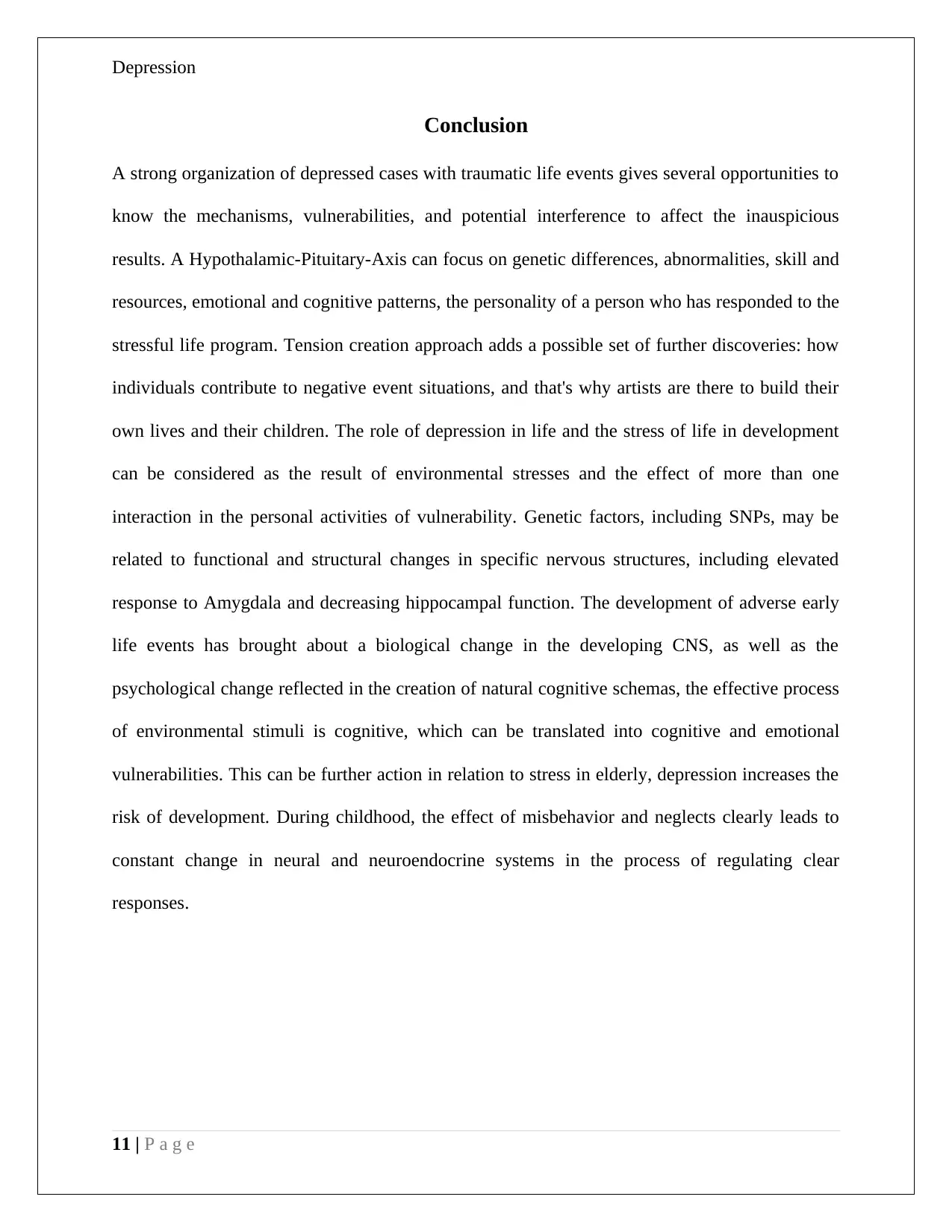
Depression
Conclusion
A strong organization of depressed cases with traumatic life events gives several opportunities to
know the mechanisms, vulnerabilities, and potential interference to affect the inauspicious
results. A Hypothalamic-Pituitary-Axis can focus on genetic differences, abnormalities, skill and
resources, emotional and cognitive patterns, the personality of a person who has responded to the
stressful life program. Tension creation approach adds a possible set of further discoveries: how
individuals contribute to negative event situations, and that's why artists are there to build their
own lives and their children. The role of depression in life and the stress of life in development
can be considered as the result of environmental stresses and the effect of more than one
interaction in the personal activities of vulnerability. Genetic factors, including SNPs, may be
related to functional and structural changes in specific nervous structures, including elevated
response to Amygdala and decreasing hippocampal function. The development of adverse early
life events has brought about a biological change in the developing CNS, as well as the
psychological change reflected in the creation of natural cognitive schemas, the effective process
of environmental stimuli is cognitive, which can be translated into cognitive and emotional
vulnerabilities. This can be further action in relation to stress in elderly, depression increases the
risk of development. During childhood, the effect of misbehavior and neglects clearly leads to
constant change in neural and neuroendocrine systems in the process of regulating clear
responses.
11 | P a g e
Conclusion
A strong organization of depressed cases with traumatic life events gives several opportunities to
know the mechanisms, vulnerabilities, and potential interference to affect the inauspicious
results. A Hypothalamic-Pituitary-Axis can focus on genetic differences, abnormalities, skill and
resources, emotional and cognitive patterns, the personality of a person who has responded to the
stressful life program. Tension creation approach adds a possible set of further discoveries: how
individuals contribute to negative event situations, and that's why artists are there to build their
own lives and their children. The role of depression in life and the stress of life in development
can be considered as the result of environmental stresses and the effect of more than one
interaction in the personal activities of vulnerability. Genetic factors, including SNPs, may be
related to functional and structural changes in specific nervous structures, including elevated
response to Amygdala and decreasing hippocampal function. The development of adverse early
life events has brought about a biological change in the developing CNS, as well as the
psychological change reflected in the creation of natural cognitive schemas, the effective process
of environmental stimuli is cognitive, which can be translated into cognitive and emotional
vulnerabilities. This can be further action in relation to stress in elderly, depression increases the
risk of development. During childhood, the effect of misbehavior and neglects clearly leads to
constant change in neural and neuroendocrine systems in the process of regulating clear
responses.
11 | P a g e
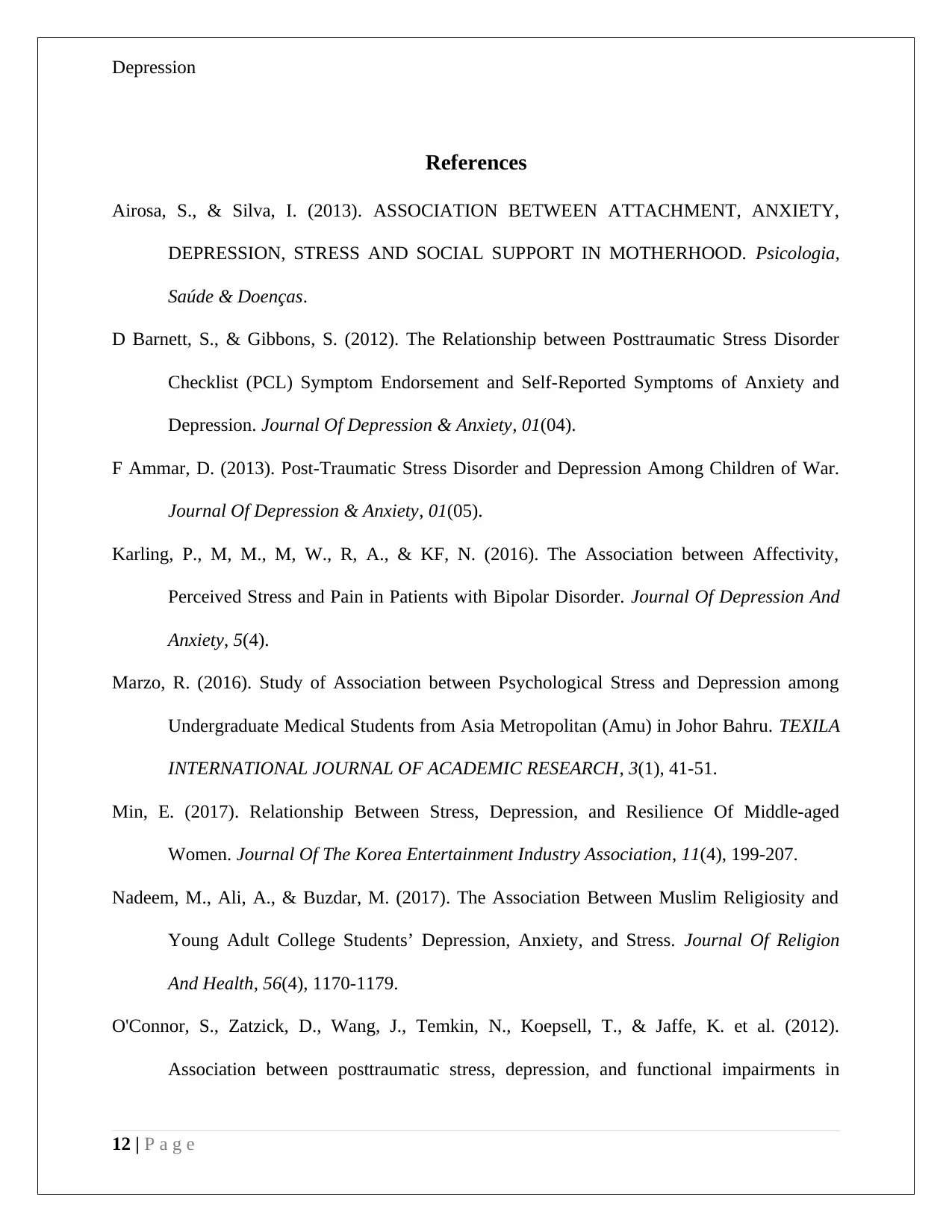
Depression
References
Airosa, S., & Silva, I. (2013). ASSOCIATION BETWEEN ATTACHMENT, ANXIETY,
DEPRESSION, STRESS AND SOCIAL SUPPORT IN MOTHERHOOD. Psicologia,
Saúde & Doenças.
D Barnett, S., & Gibbons, S. (2012). The Relationship between Posttraumatic Stress Disorder
Checklist (PCL) Symptom Endorsement and Self-Reported Symptoms of Anxiety and
Depression. Journal Of Depression & Anxiety, 01(04).
F Ammar, D. (2013). Post-Traumatic Stress Disorder and Depression Among Children of War.
Journal Of Depression & Anxiety, 01(05).
Karling, P., M, M., M, W., R, A., & KF, N. (2016). The Association between Affectivity,
Perceived Stress and Pain in Patients with Bipolar Disorder. Journal Of Depression And
Anxiety, 5(4).
Marzo, R. (2016). Study of Association between Psychological Stress and Depression among
Undergraduate Medical Students from Asia Metropolitan (Amu) in Johor Bahru. TEXILA
INTERNATIONAL JOURNAL OF ACADEMIC RESEARCH, 3(1), 41-51.
Min, E. (2017). Relationship Between Stress, Depression, and Resilience Of Middle-aged
Women. Journal Of The Korea Entertainment Industry Association, 11(4), 199-207.
Nadeem, M., Ali, A., & Buzdar, M. (2017). The Association Between Muslim Religiosity and
Young Adult College Students’ Depression, Anxiety, and Stress. Journal Of Religion
And Health, 56(4), 1170-1179.
O'Connor, S., Zatzick, D., Wang, J., Temkin, N., Koepsell, T., & Jaffe, K. et al. (2012).
Association between posttraumatic stress, depression, and functional impairments in
12 | P a g e
References
Airosa, S., & Silva, I. (2013). ASSOCIATION BETWEEN ATTACHMENT, ANXIETY,
DEPRESSION, STRESS AND SOCIAL SUPPORT IN MOTHERHOOD. Psicologia,
Saúde & Doenças.
D Barnett, S., & Gibbons, S. (2012). The Relationship between Posttraumatic Stress Disorder
Checklist (PCL) Symptom Endorsement and Self-Reported Symptoms of Anxiety and
Depression. Journal Of Depression & Anxiety, 01(04).
F Ammar, D. (2013). Post-Traumatic Stress Disorder and Depression Among Children of War.
Journal Of Depression & Anxiety, 01(05).
Karling, P., M, M., M, W., R, A., & KF, N. (2016). The Association between Affectivity,
Perceived Stress and Pain in Patients with Bipolar Disorder. Journal Of Depression And
Anxiety, 5(4).
Marzo, R. (2016). Study of Association between Psychological Stress and Depression among
Undergraduate Medical Students from Asia Metropolitan (Amu) in Johor Bahru. TEXILA
INTERNATIONAL JOURNAL OF ACADEMIC RESEARCH, 3(1), 41-51.
Min, E. (2017). Relationship Between Stress, Depression, and Resilience Of Middle-aged
Women. Journal Of The Korea Entertainment Industry Association, 11(4), 199-207.
Nadeem, M., Ali, A., & Buzdar, M. (2017). The Association Between Muslim Religiosity and
Young Adult College Students’ Depression, Anxiety, and Stress. Journal Of Religion
And Health, 56(4), 1170-1179.
O'Connor, S., Zatzick, D., Wang, J., Temkin, N., Koepsell, T., & Jaffe, K. et al. (2012).
Association between posttraumatic stress, depression, and functional impairments in
12 | P a g e
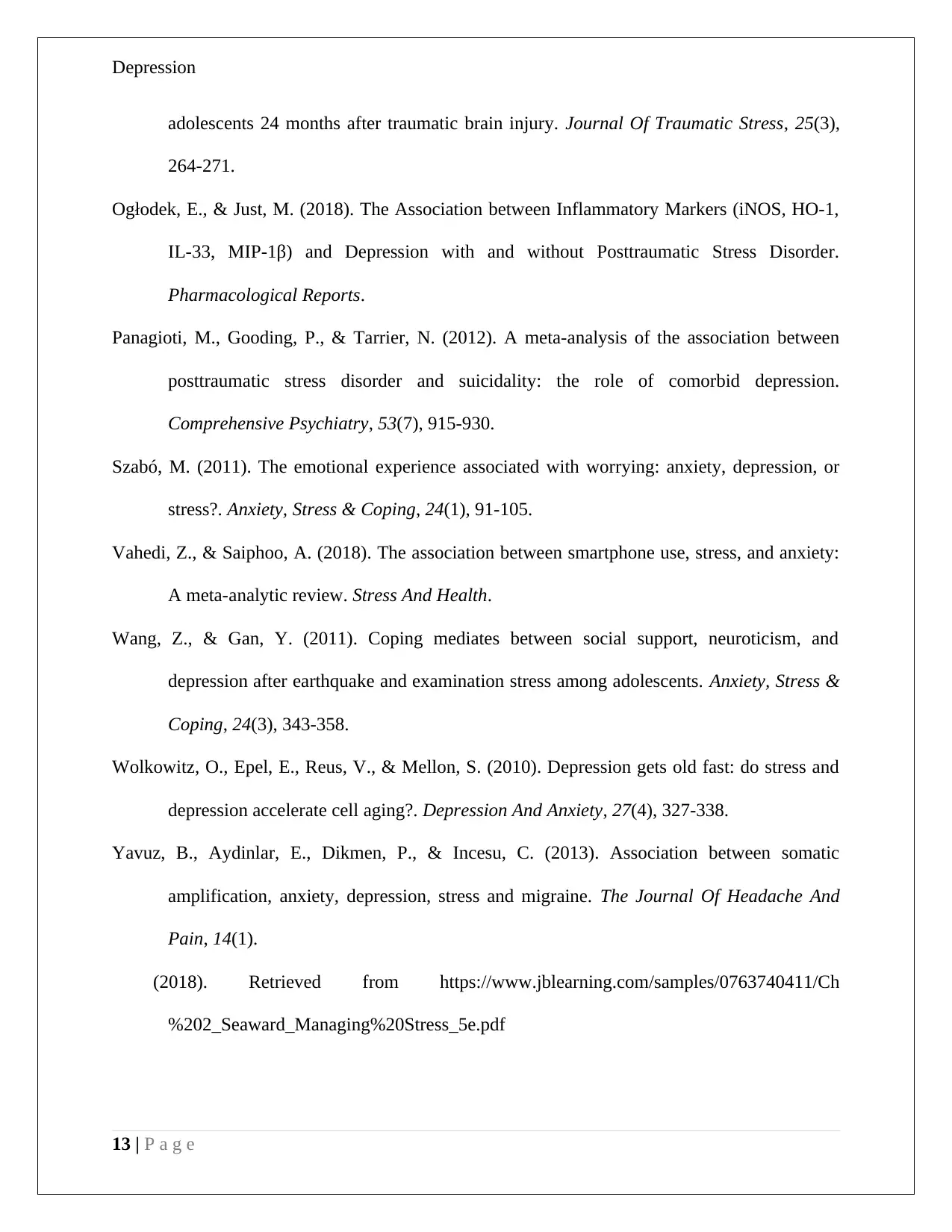
Depression
adolescents 24 months after traumatic brain injury. Journal Of Traumatic Stress, 25(3),
264-271.
Ogłodek, E., & Just, M. (2018). The Association between Inflammatory Markers (iNOS, HO-1,
IL-33, MIP-1β) and Depression with and without Posttraumatic Stress Disorder.
Pharmacological Reports.
Panagioti, M., Gooding, P., & Tarrier, N. (2012). A meta-analysis of the association between
posttraumatic stress disorder and suicidality: the role of comorbid depression.
Comprehensive Psychiatry, 53(7), 915-930.
Szabó, M. (2011). The emotional experience associated with worrying: anxiety, depression, or
stress?. Anxiety, Stress & Coping, 24(1), 91-105.
Vahedi, Z., & Saiphoo, A. (2018). The association between smartphone use, stress, and anxiety:
A meta-analytic review. Stress And Health.
Wang, Z., & Gan, Y. (2011). Coping mediates between social support, neuroticism, and
depression after earthquake and examination stress among adolescents. Anxiety, Stress &
Coping, 24(3), 343-358.
Wolkowitz, O., Epel, E., Reus, V., & Mellon, S. (2010). Depression gets old fast: do stress and
depression accelerate cell aging?. Depression And Anxiety, 27(4), 327-338.
Yavuz, B., Aydinlar, E., Dikmen, P., & Incesu, C. (2013). Association between somatic
amplification, anxiety, depression, stress and migraine. The Journal Of Headache And
Pain, 14(1).
(2018). Retrieved from https://www.jblearning.com/samples/0763740411/Ch
%202_Seaward_Managing%20Stress_5e.pdf
13 | P a g e
adolescents 24 months after traumatic brain injury. Journal Of Traumatic Stress, 25(3),
264-271.
Ogłodek, E., & Just, M. (2018). The Association between Inflammatory Markers (iNOS, HO-1,
IL-33, MIP-1β) and Depression with and without Posttraumatic Stress Disorder.
Pharmacological Reports.
Panagioti, M., Gooding, P., & Tarrier, N. (2012). A meta-analysis of the association between
posttraumatic stress disorder and suicidality: the role of comorbid depression.
Comprehensive Psychiatry, 53(7), 915-930.
Szabó, M. (2011). The emotional experience associated with worrying: anxiety, depression, or
stress?. Anxiety, Stress & Coping, 24(1), 91-105.
Vahedi, Z., & Saiphoo, A. (2018). The association between smartphone use, stress, and anxiety:
A meta-analytic review. Stress And Health.
Wang, Z., & Gan, Y. (2011). Coping mediates between social support, neuroticism, and
depression after earthquake and examination stress among adolescents. Anxiety, Stress &
Coping, 24(3), 343-358.
Wolkowitz, O., Epel, E., Reus, V., & Mellon, S. (2010). Depression gets old fast: do stress and
depression accelerate cell aging?. Depression And Anxiety, 27(4), 327-338.
Yavuz, B., Aydinlar, E., Dikmen, P., & Incesu, C. (2013). Association between somatic
amplification, anxiety, depression, stress and migraine. The Journal Of Headache And
Pain, 14(1).
(2018). Retrieved from https://www.jblearning.com/samples/0763740411/Ch
%202_Seaward_Managing%20Stress_5e.pdf
13 | P a g e
Paraphrase This Document
Need a fresh take? Get an instant paraphrase of this document with our AI Paraphraser
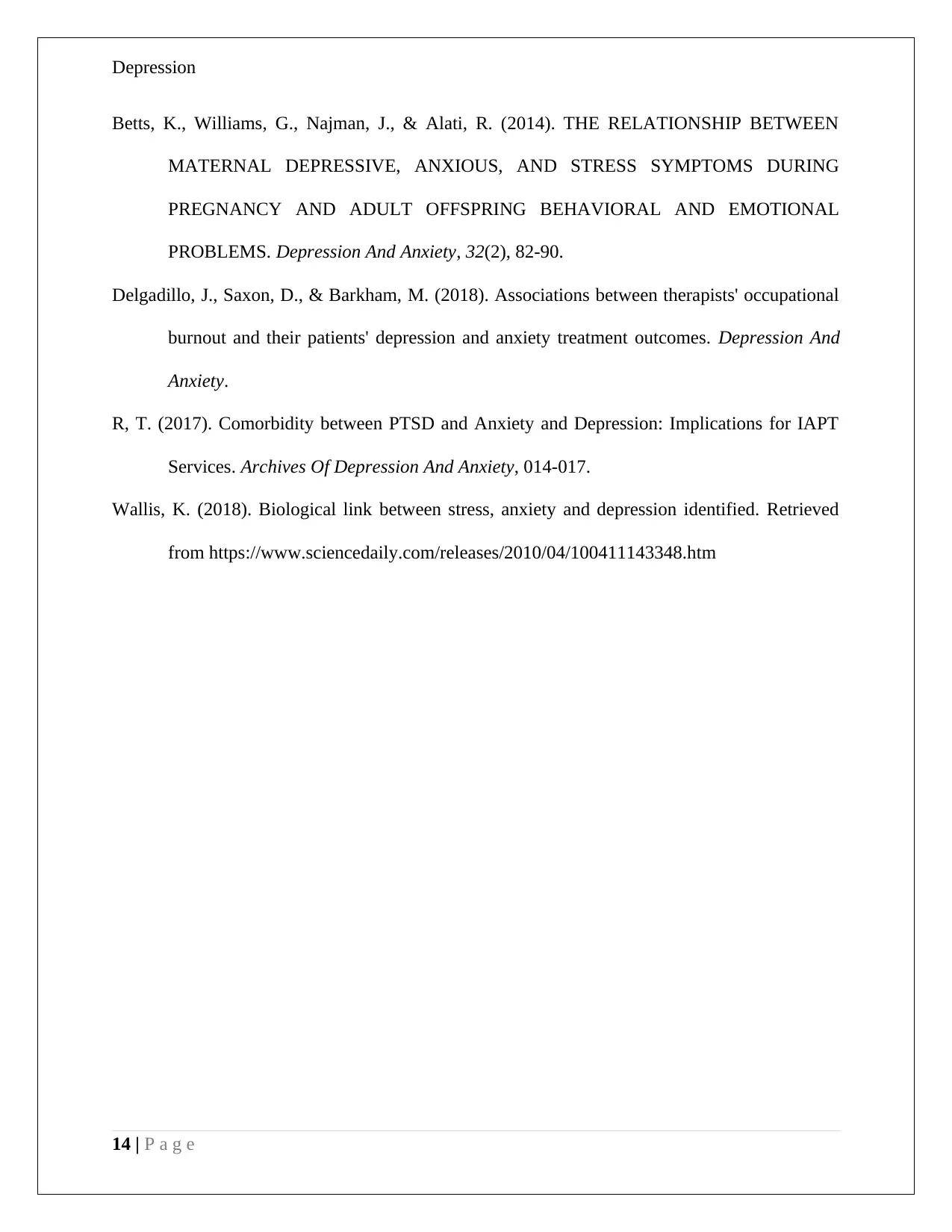
Depression
Betts, K., Williams, G., Najman, J., & Alati, R. (2014). THE RELATIONSHIP BETWEEN
MATERNAL DEPRESSIVE, ANXIOUS, AND STRESS SYMPTOMS DURING
PREGNANCY AND ADULT OFFSPRING BEHAVIORAL AND EMOTIONAL
PROBLEMS. Depression And Anxiety, 32(2), 82-90.
Delgadillo, J., Saxon, D., & Barkham, M. (2018). Associations between therapists' occupational
burnout and their patients' depression and anxiety treatment outcomes. Depression And
Anxiety.
R, T. (2017). Comorbidity between PTSD and Anxiety and Depression: Implications for IAPT
Services. Archives Of Depression And Anxiety, 014-017.
Wallis, K. (2018). Biological link between stress, anxiety and depression identified. Retrieved
from https://www.sciencedaily.com/releases/2010/04/100411143348.htm
14 | P a g e
Betts, K., Williams, G., Najman, J., & Alati, R. (2014). THE RELATIONSHIP BETWEEN
MATERNAL DEPRESSIVE, ANXIOUS, AND STRESS SYMPTOMS DURING
PREGNANCY AND ADULT OFFSPRING BEHAVIORAL AND EMOTIONAL
PROBLEMS. Depression And Anxiety, 32(2), 82-90.
Delgadillo, J., Saxon, D., & Barkham, M. (2018). Associations between therapists' occupational
burnout and their patients' depression and anxiety treatment outcomes. Depression And
Anxiety.
R, T. (2017). Comorbidity between PTSD and Anxiety and Depression: Implications for IAPT
Services. Archives Of Depression And Anxiety, 014-017.
Wallis, K. (2018). Biological link between stress, anxiety and depression identified. Retrieved
from https://www.sciencedaily.com/releases/2010/04/100411143348.htm
14 | P a g e
1 out of 14
Your All-in-One AI-Powered Toolkit for Academic Success.
+13062052269
info@desklib.com
Available 24*7 on WhatsApp / Email
![[object Object]](/_next/static/media/star-bottom.7253800d.svg)
Unlock your academic potential
© 2024 | Zucol Services PVT LTD | All rights reserved.





